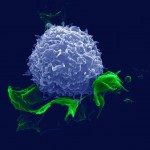Lien vers Pubmed [PMID] – 27257992
PLoS ONE 2016;11(6):e0156384
Hepatitis C Virus (HCV) infection is associated with the B-cell non-Hodgkin lymphomas (NHL), preferentially marginal zone lymphomas (MZL) and diffuse large B-cell lymphomas (DLBCL). While chronic antigenic stimulation is a main determinant of lymphomagenesis in marginal zone lymphomas (MZL), a putative role of HCV infection of B-cells is supported by in vitro studies. We performed a pathological study within the “ANRS HC-13 LymphoC” observational study focusing on in situ expression of the oncogenic HCV non structural 3 (NS3) protein. Lympho-C study enrolled 116 HCV-positive patients with B-NHL of which 86 histological samples were collected for centralized review. Main histological subtypes were DLBCL (36%) and MZL (34%). Almost half of DLBCL (12/26) were transformed from underlying small B-cell lymphomas. NS3 immunostaining was found positive in 17 of 37 tested samples (46%). There was a striking association between NS3 detection and presence of high grade lymphoma features: 12 out of 14 DLBCL were NS3+ compared to only 4 out of 14 MZL (p = 0.006). Moreover, 2 among the 4 NS3+ MZL were enriched in large cells. Remarkably, this study supports a new mechanism of transformation with a direct oncogenic role of HCV proteins in the occurrence of high-grade B lymphomas.

